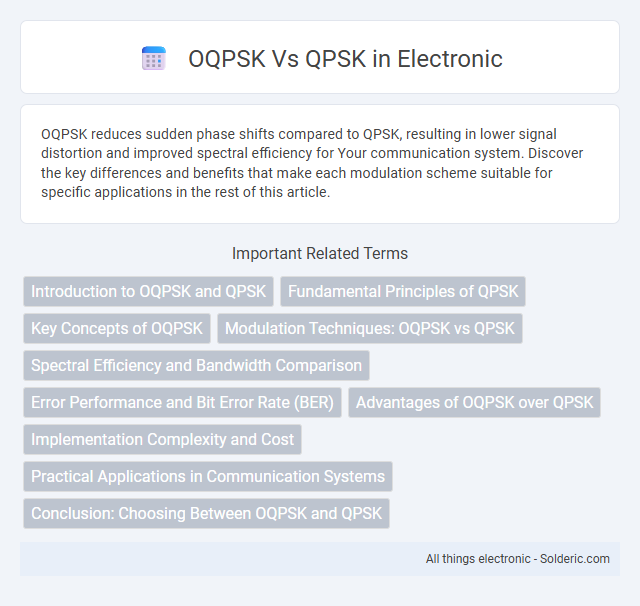OQPSK reduces sudden phase shifts compared to QPSK, resulting in lower signal distortion and improved spectral efficiency for Your communication system. Discover the key differences and benefits that make each modulation scheme suitable for specific applications in the rest of this article.
Comparison Table
| Feature | OQPSK (Offset QPSK) | QPSK (Quadrature PSK) |
|---|---|---|
| Phase Shift | 90deg offset between I and Q channels | Simultaneous 0deg, 90deg, 180deg, 270deg shifts |
| Signal Transitions | Reduced sudden phase changes, smoother transitions | Possible 180deg phase shifts causing signal distortion |
| Amplitude Fluctuations | Lower amplitude variation, better spectral efficiency | Higher amplitude fluctuations |
| Bit Error Rate (BER) | Similar to QPSK under AWGN conditions | Comparable BER performance |
| Use Cases | Satellite communications, phase-sensitive systems | Wireless LANs, cellular systems |
| Complexity | Complex timing due to offset | Simpler implementation |
Introduction to OQPSK and QPSK
OQPSK (Offset Quadrature Phase Shift Keying) and QPSK (Quadrature Phase Shift Keying) are advanced modulation schemes used in digital communication systems to enhance data transmission efficiency. OQPSK introduces a time offset between the in-phase and quadrature components to reduce sudden phase changes, minimizing signal distortion and improving error performance compared to QPSK. Understanding these key differences in phase modulation techniques helps you select the optimal method for reliable wireless data communication applications.
Fundamental Principles of QPSK
Quadrature Phase Shift Keying (QPSK) modulates data by shifting the carrier signal's phase among four distinct states equidistantly spaced at 90 degrees, enabling the transmission of two bits per symbol. Offset Quadrature Phase Shift Keying (OQPSK) differs by staggering the timing of the in-phase and quadrature components by half a symbol period to reduce sudden phase shifts, minimizing amplitude fluctuations and improving signal robustness. Your choice between OQPSK and QPSK depends on system requirements for spectral efficiency and resilience to nonlinearities in the transmission channel.
Key Concepts of OQPSK
Offset Quadrature Phase Shift Keying (OQPSK) differentiates itself from Quadrature Phase Shift Keying (QPSK) by introducing a half-symbol period offset between the in-phase (I) and quadrature (Q) components, reducing sudden phase shifts and minimizing signal amplitude fluctuations. This phase offset in OQPSK ensures that transitions occur in only one signal component at a time, effectively limiting the phase change to 90 degrees compared to the 180 degrees possible in QPSK, enhancing spectral efficiency and reducing envelope variations. Key concepts of OQPSK revolve around improving signal robustness, reducing bit error rates in nonlinear channels, and enabling more stable amplitude characteristics crucial for power amplifier efficiency in wireless communication systems.
Modulation Techniques: OQPSK vs QPSK
OQPSK (Offset Quadrature Phase Shift Keying) and QPSK (Quadrature Phase Shift Keying) are both advanced modulation techniques used in digital communication to efficiently transmit data by encoding bits into phase changes of a carrier signal. OQPSK differs by offsetting the timing of the in-phase and quadrature components, reducing phase transitions that pass through zero amplitude, which minimizes signal distortion and improves signal integrity, especially in nonlinear channels. Your choice between OQPSK and QPSK depends on system requirements for power efficiency and spectral characteristics, with OQPSK offering better resilience to amplitude fluctuations and QPSK providing simpler implementation.
Spectral Efficiency and Bandwidth Comparison
OQPSK (Offset Quadrature Phase Shift Keying) offers improved spectral efficiency over QPSK by minimizing phase transitions, which reduces signal distortion and allows for tighter bandwidth allocation. The inherent offset in OQPSK halves the maximum phase shift compared to QPSK, resulting in a lower peak-to-average power ratio (PAPR) and less spectral spreading. Your communication system can benefit from OQPSK's narrower bandwidth occupancy, enhancing signal clarity and reducing interference in crowded frequency bands.
Error Performance and Bit Error Rate (BER)
OQPSK (Offset Quadrature Phase Shift Keying) typically offers better error performance and lower Bit Error Rate (BER) than QPSK (Quadrature Phase Shift Keying) under similar signal-to-noise ratio (SNR) conditions due to its reduced phase transitions that prevent 180-degree shifts causing signal distortion. Your communication system benefits from OQPSK's minimized symbol error probability, especially in fading channels, enhancing reliable data transmission. BER for OQPSK is generally lower because the offset in phase transitions reduces inter-symbol interference, improving overall link robustness in wireless applications.
Advantages of OQPSK over QPSK
OQPSK (Offset Quadrature Phase Shift Keying) reduces the abrupt phase transitions seen in QPSK (Quadrature Phase Shift Keying), minimizing signal distortion and improving spectral efficiency. This smoother phase shift lowers the risk of envelope fluctuations, enhancing performance in nonlinear amplifier environments. Your communication system benefits from increased robustness and better error performance, especially in satellite and wireless applications.
Implementation Complexity and Cost
OQPSK (Offset Quadrature Phase Shift Keying) generally offers reduced implementation complexity compared to QPSK (Quadrature Phase Shift Keying) due to its staggered signal timing, which minimizes phase transitions and simplifies transmitter design. This results in lower hardware requirements and cost savings, particularly in systems where power efficiency and linearity are critical. Your choice between OQPSK and QPSK will impact overall system expenses, with OQPSK often preferred for cost-sensitive applications requiring reliable performance.
Practical Applications in Communication Systems
OQPSK (Offset Quadrature Phase Shift Keying) is favored in satellite and cellular communication systems due to its lower signal envelope fluctuations, which reduce power amplifier distortion and improve signal integrity. QPSK (Quadrature Phase Shift Keying) is widely used in wireless LANs, digital TV broadcasting, and RFID systems because of its higher spectral efficiency and simpler demodulation. Your choice between OQPSK and QPSK depends on the specific system requirements, such as power efficiency and robustness against nonlinear channel effects.
Conclusion: Choosing Between OQPSK and QPSK
OQPSK offers reduced phase transitions compared to QPSK, resulting in lower signal distortion and improved performance in nonlinear channels, making it ideal for power-limited or interference-prone environments. QPSK provides simpler implementation and higher spectral efficiency, which suits applications requiring cost-effectiveness and bandwidth optimization. Your choice depends on the priority between minimizing signal distortion with OQPSK or maximizing spectral efficiency and simplicity with QPSK.
OQPSK vs QPSK Infographic

 solderic.com
solderic.com